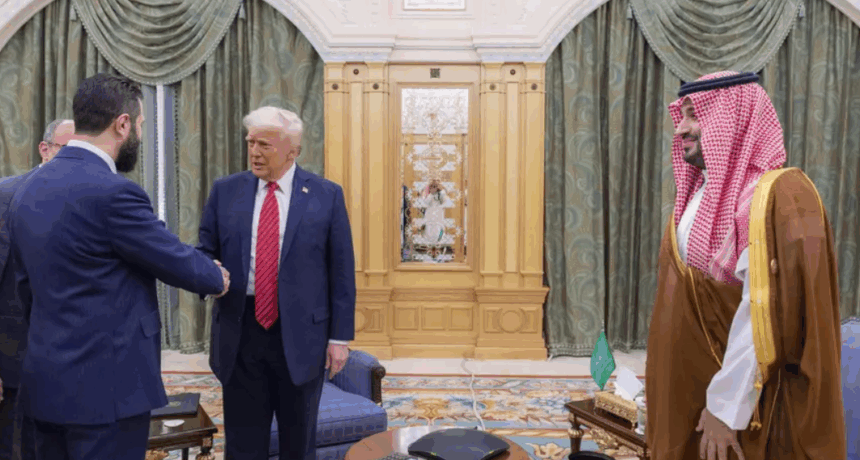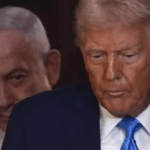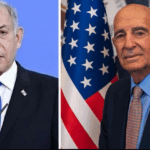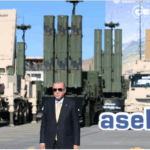It may be one of the great ironies of our time: Donald Trump, the most polarizing American president in recent history, may have just launched the most consequential soft power pivot the United States has made in the Middle East since the Cold War.
In a geopolitical twist few anticipated, Donald Trump—whose presidency has long been synonymous with unilateralism, transactionalism, and disdain for norms—now appears to be staging a soft power comeback in the Middle East. Or so he would have us believe.
Critics have long accused Trump of gutting America’s global credibility, hollowing out its alliances, and replacing values with brute transaction. But recently, something unusual is taking shape: from freezing out Israeli Prime Minister Benjamin Netanyahu to meeting with a former jihadist-turned-Syrian interim president, Trump is remapping American diplomacy in the region. He has dropped sanctions, shaken hands with former enemies, and proposed sweeping regional development plans. Supporters call it bold realignment; critics see an erratic blend of opportunism, vanity diplomacy, and abandonment of longstanding values.
But this emerging pivot cannot be divorced from a deeper, darker context: America’s global image has suffered immense damage from its unflinching support for Israel during its devastating military campaign in Gaza. While much of the world has come to view Israel’s actions—including the destruction of hospitals, refugee camps, and entire residential districts—as constituting war crimes or even genocide, the United States stood virtually alone in shielding Israel from accountability, both rhetorically and diplomatically. Washington repeatedly vetoed UN Security Council resolutions calling for a ceasefire, delivered weapons mid-conflict, and framed the slaughter of civilians as self-defense.
In doing so, the U.S. severely eroded its moral credibility—not only in the Arab world, but across the Global South, where it is now seen as a selective defender of human rights. The soft power it once wielded through the promise of liberal values, democratic governance, and international law has been replaced by a stark image: the United States as enabler-in-chief of one of the most lopsided wars in recent memory.
Trump’s posturing now—as a regional fixer, a rebuilder, a statesman—rings hollow against that backdrop. Either he is trying to rehabilitate a tarnished image through a burst of diplomatic theater, or he is capitalizing on the wreckage that U.S. policy helped create. Either way, something is shifting. And it deserves scrutiny.
A Calculated Divorce: Trump Leaves Netanyahu Behind
Trump’s abrupt distancing from Netanyahu is perhaps the most jarring indicator of this pivot. The two were once inseparable—ideological twins riding the same populist wave, jointly reshaping U.S.-Israel policy in ways that stunned even pro-Israel hawks. Trump’s first term gave Israel everything it wanted: recognition of Jerusalem as its capital, endorsement of Israeli sovereignty over the Golan Heights, unwavering support in the United Nations, and the Abraham Accords as a regional diplomatic breakthrough.
Now? Netanyahu is nowhere to be seen. Trump’s latest Middle East tour bypassed Israel entirely. In Riyadh, he met with Gulf leaders, Syrian interim President Ahmed al-Sharaa, and even floated the idea of normalization with Israel—without so much as a consultation with Israeli officials.
But this isn’t just diplomatic distancing; it’s a pointed, calculated snub. And the signals began even before Trump was sworn in for his second term.
Just days before his inauguration, Trump shared a video on social media featuring a Columbia University professor referring to Netanyahu as a “dark son of a bitch” who is “obsessive in trying to get us to fight Iran.” By amplifying this clip, Trump not only distanced himself from Netanyahu but also publicly endorsed a scathing critique of the Israeli leader’s foreign policy approach. The move sent shockwaves through Israeli media and diplomatic circles—not just for its vulgarity, but for what it symbolized: a deliberate public humiliation of a longtime ally.
While the Trump campaign later brushed it off as satire, the timing was anything but accidental. The video came amid rising tensions over Israel’s conduct in Gaza and growing frustration among Gulf leaders over Netanyahu’s defiance of U.S. and Arab pressure to curb military operations. It was Trump’s way of broadcasting his break with Netanyahu—loudly, offensively, and with unmistakable theatricality.
It also raises deeper questions: Has Israel’s strategic value in Trump’s eyes simply diminished? Or is this pivot driven less by vision and more by personal grievance?
Because let’s be clear—Trump has never done anything without a personal angle. Netanyahu’s political stock is plummeting at home, his military campaign in Gaza has triggered global outrage, and he failed to deliver on key Trump-era expectations, including preventing a full-scale war that now threatens U.S. regional ambitions.
Their diverging approaches to Gaza are instructive. Netanyahu seeks control through continued militarization and nationalist defiance. Trump, on the other hand, wants a Gaza that can be privatized, pacified, and monetized—a Singapore on the Mediterranean, not a battlefield. Their paths are no longer just diverging; they are irreconcilable.
What Trump now markets as a “bold reimagining of the region” may, in reality, be a tactical and vengeful abandonment of a weakened partner who no longer serves his ambitions. And if that’s the case, this is not a soft power strategy—it’s a power play dressed in diplomacy.
The Gaza “Freedom Zone”: Visionary or Cynical Fantasy?
Perhaps the most emblematic piece of Trump’s Middle East rebrand is his “Freedom Zone” plan for Gaza. Drawing inspiration from Singapore and Dubai, the proposal envisions a depoliticized, tech-driven, investor-friendly enclave along the Mediterranean—funded by Gulf capital, overseen by American security contractors, and surgically detached from nationalist politics or Israeli oversight.
The imagery is striking: cranes replacing rockets, free markets supplanting militias, beachfront startups rising where refugee camps once stood. It’s a glossy, seductive vision. But it is also deeply fantastical.
Who will govern this zone? What legitimacy will it have among Palestinians? Will the 2.2 million residents of Gaza be treated as partners in reconstruction or simply as labor for a foreign-designed enclave? Trump’s proposal avoids every thorny issue—occupation, borders, political rights, the siege, refugee return, and elections—and replaces them with buzzwords: “opportunity,” “innovation,” “stability.”
In a parallel development that would have been unthinkable just a few years ago, Hamas has publicly confirmed it is engaged in direct peace talks with U.S. officials. These talks have included American proposals for a phased ceasefire, partial demilitarization of Hamas forces, and guarantees for reconstruction and political participation—all without Israeli mediation.
Hamas, in turn, has urged Trump to pressure Israel to halt its military campaign and engage in a comprehensive political process. For a U.S. administration that once designated Hamas as untouchable, this is a stunning shift. It signals not only a break with Netanyahu, but also a broader recalibration: Gaza is no longer seen solely as a security problem—it’s being reframed as a potential entry point for American influence, business, and regional engineering.
Syria: From State Sponsor to Silent Partner
In perhaps his most controversial move yet, Trump lifted all U.S. sanctions on Syria and met with Ahmed al-Sharaa, the country’s new interim president. The U.S. State Department still officially classifies al-Sharaa—better known by his former alias Abu Mohammed al-Golani—as a former terrorist leader. He previously headed al-Qaeda’s Syrian affiliate, Hayat Tahrir al-Sham (HTS), and was once one of Washington’s most-wanted men. Now, he’s shaking hands with the U.S. president in Riyadh.
Within hours of Trump’s announcement, crowds flooded into Damascus’s Umayyad Square. Men, women, and children danced in the streets, waving Syrian flags, blasting music, and celebrating as though a war had ended. For a nation battered by more than a decade of sanctions, war, and diplomatic exile, the prospect of economic reintegration and political normalization was a rare reason for hope.
The Syrian Foreign Ministry welcomed Trump’s decision as a “pivotal turning point,” declaring it an opportunity for the Syrian people to “emerge from a long and painful chapter of war.” The statement framed the sanctions relief not merely as a diplomatic gesture but as a lifeline—one that could enable Syria to rebuild, stabilize, and reclaim its sovereignty.
Soft Power, or Soft Authoritarianism?
Trump’s defenders argue that this is all part of a larger soft power strategy—an effort to reframe America as a builder rather than a bomber. He’s engaging former adversaries, shifting focus from conflict to capital, and expanding diplomatic channels.
But is this really soft power?
Joseph Nye, who coined the term, defined soft power as the ability to shape preferences through attraction rather than coercion. It stems from legitimacy, moral authority, and cultural appeal—not brute deals with strongmen.
Trump’s “soft power” is something different: transactional diplomacy dressed in visionary rhetoric, often ignoring human rights, accountability, or democratic norms. It is soft power stripped of its ethical core.
And while it may yield short-term photo ops or economic gains, its long-term impact is unclear. Is the U.S. empowering legitimate local actors—or simply legitimizing whoever can deliver regional compliance and a handshake?
Conclusion: Between Attraction and Expediency
Donald Trump’s second-term Middle East pivot is a paradox. On the surface, it echoes the language of soft power: economic opportunity, partnership, reconstruction. But beneath, it remains a hard-nosed pursuit of influence through spectacle, not substance.
If this is a genuine pivot to diplomacy, it should be welcomed. But we must also ask: What happens when Trump loses interest? What happens when these fragile partnerships unravel? Are we rebuilding the region—or simply repainting it?
One cannot ignore the contradictions. Trump has undermined multilateralism, exited treaties, silenced civil diplomacy (Voice of America, USAID), and derided “nation-building.” Now, he wants to build Gaza, embrace Syria, and befriend Gulf royals. What changed—other than the casting?
By dumping Netanyahu, lifting sanctions on Syria, and proposing a neoliberal fantasy in Gaza, Trump is repositioning the United States—not as a beacon of democracy, but as a regional dealmaker-in-chief. It’s a form of engagement, yes—but one rooted in convenience, not conviction.
America’s soft power may be back. But whose power is it, really?
By: Geopolist | Istanbul Center for Geopolitics







